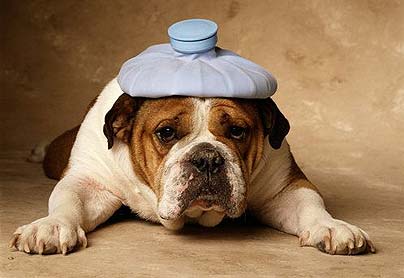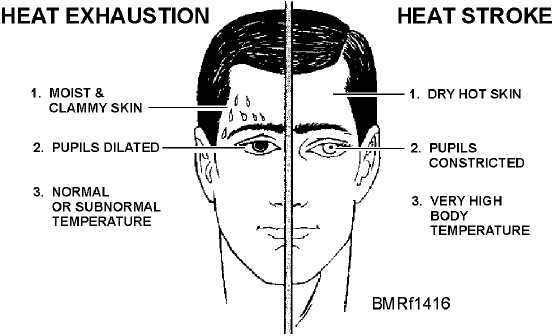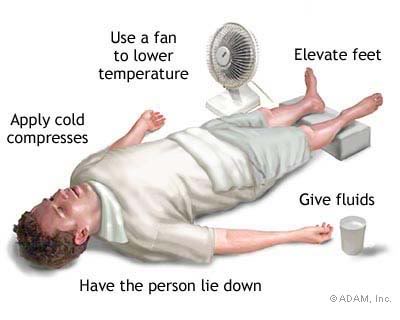It is that time of year again where the sun is up longer and is more intense than we are used to in most cases. With that in mind, please review the following and keep a close eye on your students and fellow instructors.
Heat Exhaustion (Mayo Clinic)
Heat exhaustion is a condition whose symptoms may include heavy sweating and a rapid pulse, a result of your body overheating. It’s one of three heat-related syndromes, with heat cramps being the mildest and heatstroke being the most severe.
Causes of heat exhaustion include exposure to high temperatures, particularly when combined with high humidity, and strenuous physical activity. Without prompt treatment, heat exhaustion can progress to heatstroke, a life-threatening condition. Fortunately, heat exhaustion is preventable.
Signs and symptoms of heat exhaustion may come on suddenly or may develop after days of heat exposure. Possible heat exhaustion signs and symptoms include:
* Cool, moist skin with goose bumps when in the heat
* Heavy sweating
* Faintness
* Dizziness
* Fatigue
* Weak, rapid pulse
* Low blood pressure upon standing
* Muscle cramps
* Nausea
* Headache
If you think you’re experiencing heat exhaustion:
* Stop all activity and rest
* Move to a cooler place
* Drink cool water or sports drinks
Contact your doctor if your signs or symptoms worsen or if they don’t improve within 60 minutes. Seek immediate medical attention if your body temperature reaches 104 F (40 C) or higher.
Heatstroke (Mayo Clinic)
Heatstroke is a life-threatening condition that occurs when your body temperature reaches 104 F (40 C) or higher. Heatstroke can be brought on by high environmental temperatures, by strenuous physical activity or by other conditions that raise your body temperature. Whatever the cause, you’ll need immediate medical attention to prevent brain damage, organ failure or death.
Heatstroke is the escalation of two other heat-related health problems: heat cramps and heat exhaustion. In these conditions, you develop signs and symptoms that are milder than those of heatstroke. You can prevent heatstroke if you receive medical attention or take self-care steps as soon as you notice problems.
Heatstroke symptoms include:
* High body temperature. A body temperature of 104 F (40 C) or higher is the main sign of heatstroke.
* A lack of sweating. In heatstroke brought on by hot weather, your skin will feel hot and dry to the touch. However, in heatstroke brought on by strenuous exercise, your skin usually feels moist.
* Flushed skin. Your skin may turn red as your body temperature increases.
* Rapid breathing. Your breathing may become rapid and shallow.
* Racing heart rate and strong pulse (tachycardia). Your pulse may significantly increase because heat stress places a tremendous burden on your heart to help cool your body.
* Headache. You may experience a throbbing headache.
* Neurological symptoms. You may have seizures, lose consciousness, slip into a coma, hallucinate, or have difficulty speaking or understanding what others are saying.
* Muscle cramps or weakness. Your muscles may feel tender or cramped in the early stages of heatstroke, but may later go rigid or limp.
When to see a doctor
If you think you have heat cramps or the beginning signs and symptoms of heat exhaustion, first try to cool yourself and replenish your water and salt levels. If your condition has progressed past heat cramps and heat exhaustion and you feel any of the symptoms of heatstroke, seek immediate medical attention.
Added Notes:
One key — pre-hydrate.
The night before class is by no means too soon to start drinking more than usual.
Certainly on the way to the range, and before you shoot — drink.
Balancing electrolytes is key. Drink all Gatorade and you are likely getting too many carbs and lytes and not keeping cells wet. Drink only water and you are likely washing out lytes.
Alternate a big water and a small gatorade or sports drink. Also make sure to eat a banana on the way in. YMMV, but the concept is key.
If you don’t have to pee, you are not drinking enough.
Knees wobbly? Feeling slow or dumb? Get the shade and drink.
Most Notable:
Heat exhaustion and heatstroke is nothing to take lightly.
If you think you are getting heat exhaustion let someone know immediately so corrective action can be take.
Don’t be dumb or macho by keeping your mouth shut and denying it is happening to you.
It can kill and does kill people.






Scott
Good article and very timely. I know a Safety Officer that I’ve personally given first aid to twice for heat related issues. You know the one who shows up for a day on the range with a 10oz. bottle of water that graces their pocket all day.
I would add one item to the heat related precautions- Sunscreen. Skin Cancer is no joke.
Be Safe
2 clear pee’s a day! A good rule of thumb for pre hydration before outdoor activity is 1 ounce of water per kilo of body weight (180 lb is approx 80 ounces of water).
Very good advice Scott. I took 103 with you last summer in conditions like you described above. It was hotter than hell.
Although heat cramps can be quite painful, they usually don’t result in permanent damage. In order to prevent them, one may drink electrolyte solutions such as sports drinks during exercise or eat potassium-rich foods like bananas.:::,
Until next time http://www.picturesofherpes.co
My brother suggested I might like this website. He was totally right.
This post truly made my day. You can not imagine just how
much time I had spent for this info! Thanks!
The most common causes of muscle cramps are overuse, injury or strain. However, myalgia can also be caused by diseases, disorders, medications, or as a response to a vaccination. It is also a sign of acute rejection after heart transplant surgery.^’`.
Check out our own web portal too <http://www.healthmedicinebook.com/index.php